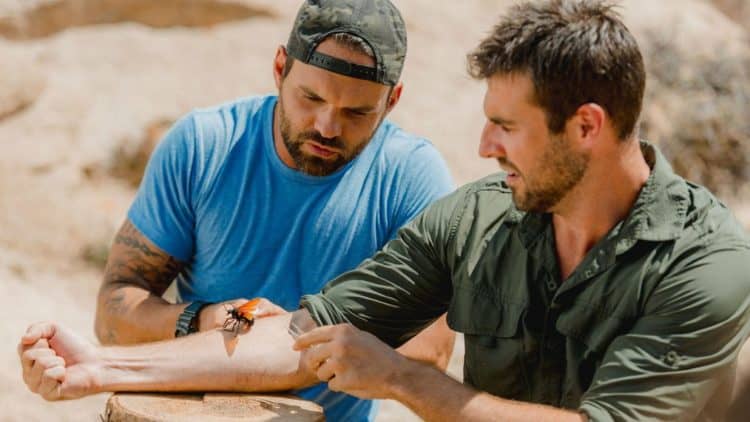
Kings of Pain is a History show centered on a couple of individuals. The first individual is Adam Thorn, who is a wildlife biologist. Meanwhile, the second individual is Rob “Caveman” Alleva, who is an animal handler. Given the name of the show, it should come as no surprise to learn that Kings of Pain is centered on the science of pain, which is much more important than what people might expect. Here are 10 things that you may or may not have known about Kings of Pain:
1. The Goal Is to Establish a Pain Index
The two stars of the show are working on a pain index. Essentially, they want to create a comprehensive guide for measuring pain by building upon the foundations laid out by the entomologist Dr. Justin O. Schmidt. As for why people would be interested in a pain index, the ability to express pain in quantitative rather than qualitative terms is very useful in a wide range of contexts. For instance, the measurement of pain plays an important role in determining a person’s quality of life, which in turn, is critical for guiding healthcare decisions on a societal scale.
2. The Process Involves Self-Experimentation
As for how the two stars of the show are going to make a pain index, the answer is both simple and straightforward. In short, they are going to get either bitten or stung by various animals so that they can rate the experiences based on the intensity of the pain, the duration of the pain, the degree of the damage that was inflicted, as well as other factors. Suffice to say that this kind of self-experimentation has a long history in the sciences, as shown by how Schmidt did something similar to create his pain index.
3. Each Episode Follows a Formula
Each episode of Kings of Pain follows the same formula. In short, the two stars track the focus animal, capture the focus animal, and then proceed with the testing while being watched over by a medic. Perhaps unsurprisingly, it is the medic who provides the viewers with information about what the bite or sting is doing to the two stars, who are often not in the right condition to handle that part of the responsibilities.
4. Features Warrior Wasps
The first episode features warrior wasps, which can be found in certain forested regions of both Central America and South America. These wasps have barbed stingers, meaning that they will often die when they sting people. However, that won’t come as much consolation to their victims when warrior wasps for infamous for having very painful stings. Never mind the fact that they come in aggressive swarms.
5. Features Executioner Wasps
Moving on, the show features executioner wasps, which are a species of paper wasps that can be found in both Central America and South America as well. Their scientific name is Polistes carnifex. For those who are curious, Polistes means “city-builder” in reference to how they build their nests, while carnifex means “executioner.” Due to this, interested individuals might not be very surprised to learn that executioner wasps hunt caterpillars, chew up the flesh of the caterpillars, and then feed the result to the larvae in their bests.
6. Features Goliath Birdeaters
Goliath birdeaters are an arachnophobe’s nightmare. This is because they can have a leg span of up to 12 inches, thus making them more than big enough to live up to their name. With that said, goliath birdeaters aren’t particularly dangerous to humans. They do have a venomous bite, but their venom isn’t that much worse than that of a standard wasp sting. Besides that, goliath birdeaters are also capable of launching their barbed hairs to cause painful irritation. Unfortunately for them, it isn’t unknown for locals in South America to singe their hair off before wrapping them up in banana leaves for cooking.
7. Features Lionfish
The lionfish is native to the Indian Ocean but has managed to become an invasive species in the Atlantic Ocean thanks to careless aquarium owners. It is a very recognizable creature, seeing as how it has colorful patterns matched with long, venomous spikes. In recent times, there are some parties that have been pushing for the eating of lionfish as a way of bringing down their numbers, seeing as how they are perfectly edible so long as they have been prepared in the right manner.
8. Features Tarantula Hawks
There are poisonous birds out there, but tarantula hawks aren’t one of those species. Instead, tarantula hawks are wasps called thus because they specialize in paralyzing tarantulas so that the unfortunate victims can be used as a source of food for the eggs implanted in them. Fortunately, the tarantula hawk’s sting isn’t particularly poisonous. In fact, it is supposed to be less poisonous than a honeybee. Unfortunately, the tarantula hawk’s sting is hideously painful, so much so that it is beaten out by just bullet ants when it comes to that particular criterion.
9. Features Crown-of-Thorns Starfish
Crown-of-thorns starfish are a huge nuisance, not least because they are avid coral eaters and thus serious threats to the well-being of the planet’s remaining coral reefs. On top of this, they have defensive stings that can break off in their victim’s tissues, meaning that the stings will have to be surgically removed. Depending on the exact region, the crown-of-thorns starfish’s sting can range from being relatively harmless to being capable of inflicting serious pain, persistent bleeding, and other symptoms for more than a week’s time.
10. Features Toe Biters
Toe biters refer to water bugs of considerable size that can be found in a wide range of places throughout the world. It isn’t uncommon for the biggest examples to hit more than 4.5 inches in length, which is enough to enable them to predate upon a very wide range of species. For example, these water bugs have been known to eat everything from fish to tadpoles. On top of that, they have even been known to chow down on ducklings when they get the chance. Having said that, humans being humans, it is perhaps unsurprising that they are eaten as delicacies in certain Asian countries when they have been properly fried.
 Follow Us
Follow Us





